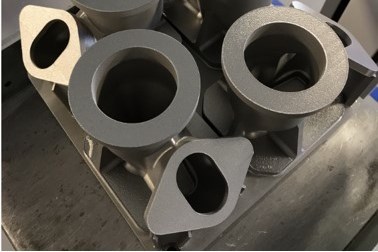GE Aviation Switches Four Existing Cast Parts to Metal 3D Printing
GE engineers say additive manufacturing can compete with casting as its improved productivity lowers cost and slashes development time.

GE vent cap
GE Aviation and GE Additive collaborated on validating the switch of four investment cast parts to ones made by metal additive manufacturing (AM), making the decision based on cost and time to market. The parts include four bleed air parts from a land/marine turbine, which were chosen following an extensive annual audit of castings.
The engineering team expects its four 3D-printed parts will slash up to 35% of their cost — which is enough to justify retiring the old casting molds forever. Equally important is that the conversion process took only 10 months to go from identifying target parts to 3D printing final prototypes. Ordinarily, producing aerospace and land/marine turbine parts using a casting process takes 12 to 18 months or more.
“This is a game changer,” says Eric Gatlin, GE Aviation additive manufacturing said. “This is the first time we did a part-for-part replacement, and it was cheaper doing it with additive than casting. To make sure we demonstrated cost competitiveness, we had four outside vendors quote the parts, and we still came in lower with additive manufacturing.”
According to the team, this is just the beginning. The project has identified scores of other parts on a variety of engines which they could convert to AM and save cost.
Part consolidation is another benefit of switching to AM. The 3D-printed fuel nozzle tip for GE Aviation’s LEAP engine, for example, consolidates 20 different parts — and the steps needed to machine and assemble them — into one single structure. The company’s new turboprop engine took that to another level by combining 855 parts into just 10 3D-printed components.
In both cases (and others), GE Aviation took advantage of parts consolidation to squeeze major cost savings from assembling these parts. The parts were one-to-one replacements, without any redesign or parts consolidation to improve their economics, according to Gatlin. And it was done fast.
Related Content
-
“Mantis” AM System for Spacecraft Uses Induction for Deposition
The metal 3D printing system melts wire without lasers. 30-foot-diameter parts are built on a rotary-feed system that eliminates the need for a large machine frame or gantry.
-
Video: For 3D Printed Aircraft Structure, Machining Aids Fatigue Strength
Machining is a valuable complement to directed energy deposition, says Big Metal Additive. Topology-optimized aircraft parts illustrate the improvement in part performance from machining as the part is being built.
-
Beehive Industries Is Going Big on Small-Scale Engines Made Through Additive Manufacturing
Backed by decades of experience in both aviation and additive, the company is now laser-focused on a single goal: developing, proving and scaling production of engines providing 5,000 lbs of thrust or less.













